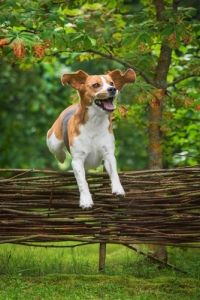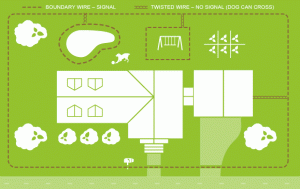How to stop the dog escaping from the garden
Want to learn how to keep your dog in your garden?
Is your dog getting out more than you? Dog owners often search for solutions on to how to stop the dog escaping from the garden. Why, because; responsible dog owners know that having a securely fenced garden is a non-negotiable must for just about any dog. Dogs are inveterate explorers, and for some, the garden is just not a big enough or interesting enough place to stay. If escape is in your dog’s DNA, the first thing to remember is that these dogs are really just natural adventurers. And remember, too, that in a good number of cases, it’s as much about what you’re doing inside as it is about what’s happening outside when the dog makes a break for it.
Your dog might wander off because they feel lonesome. Even if there’s a lot of open space, all your dog might really want is your companionship. Or, they could just be seeking out a new buddy. Then there’s the territorial type. These dogs might roam around the outside of the property because they’ve sensed some possible intrusion and are just doing what they think is best to defend their home. And let’s not forget about those adventurous, “What if…?” dogs that have just discovered the other side of a fence. Whether it be a newfound friend, a secret stash of grub, an inviting body of water, or an ephemeral scent leading to the wild, these dogs are not afraid to explore a little bit beyond the hard boundaries of the property line.
Make the garden a happy place for your dog. The garden should be a sanctuary—safe and secure, a sunlit and shaded space for the dog to lounge in, and a haven. You should also spend time in the garden with your dog when possible, engaging in play and training games that will keep your pup interested and busy.
Even if you have a securely fenced-in garden, it is essential to walk your dog daily, and to do so with great enthusiasm. The nature of the exercise and the environment used during the walk are both important. You need to make every effort to use both physical and mental tactics to tire your dog out, using a fenced garden as a starter. Walk your dog every day and really if possible twice a day and try to vary your walk to keep your dog energetic and enthusiastic.
What fencing options are there to stop the dog escaping garden?
There are of course many types of fencing for dogs and cats. If it’s just the rear garden you might want to try a traditional fence but these can work out costly depending on the size and terrain of the garden. If you have a dog or cat that climbs then you can install roller topper on top of the fencing. These long, metal bars are installed to the top of a fence, and when a pet attempts to use it to gain some sort of grip to pull itself over, it rolls, like a rolling pin but if you’ve got a digger then your options can be even more costly!
The solution to a digger would be create a substantial barrier that even the most persistent digger cannot circumvent by pouring a concrete into the ground and running pour it along the edge of the fence. These solutions are rather hammer to crack a nut and create quite a disturbance to your perimeter boundary.
disturbance to your perimeter boundary.
Dog runs are effective people may think that they have to keep their dogs in a run in order to keep them safe and give them fresh air but surely this is akin to how we keep prisoners? Not only are they very costly to give your dog a small area of freedom, they are extremely unsightly. Your dog can and should have freedom to enjoy life in the garden, even if you’re not there with them. An electronic dog fence is solution that give both dogs and cats freedom and safety.
What is an electronic dog fence?
An electronic dog fence, also known as an invisible or wireless dog fence, is a containment system designed to keep pets within a designated area without the need for traditional physical barriers like wooden or chain-link fences. Instead of constructing a visible fence, the electronic system creates an invisible boundary that, when crossed by the dog, triggers a warning or correction signal, ensuring that the dog remains within the specified perimeter. This innovative solution is popular among pet owners who want to maintain an open view of their landscape, avoid the cost of traditional fencing, or live in areas where building physical fences may not be feasible.
How Does an Electronic Dog Fence Work?

An electronic dog fence system generally consists of three main components:
Transmitter: This device is responsible for creating the boundary. It can either be installed indoors or outdoors, depending on the type of system, and transmits a radio signal to establish the boundary line. The coverage area can vary, with some systems covering small yards or gardens, and others spanning several acres.
Boundary wire: A boundary wire is buried around the perimeter of the property (up to 350 acres), which can be customised to fit any shape or size of the garden or property. This wire creates the boundary signal that is picked up by the dog’s receiver collar. These systems offer more flexibility in shaping the boundary. The wire carries a harmless radio signal (it an underground aerial).
Receiver Collar: The dog wears a special collar equipped with a receiver. When the dog approaches the boundary, the collar picks up a warning signal transmitted by the underground wires or wireless system.
Boundary Markers: Physical flags are often used during the initial training phase to help the dog or cat visually understand where the boundary lies.
Will an electronic dog fence stop the dog from escaping from the garden? Yes, they are highly effective and when installed by DogFence UK, the owner even receives a guarantee.
If you want to learn more about how we can keep your dogs and cats safe contact us or call us today 01628 476475




